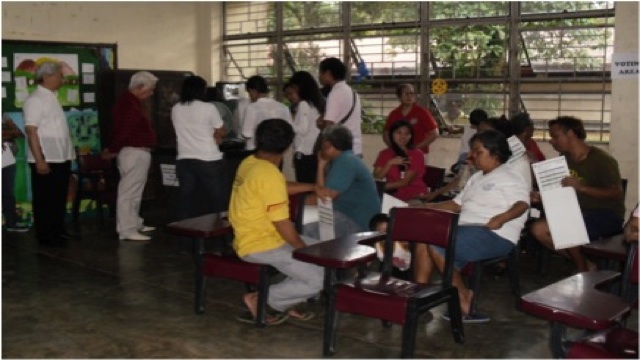SUMMARY
This is AI generated summarization, which may have errors. For context, always refer to the full article.

MANILA, Philippines – Mock elections held at the University of the Philippines Integrated School started with a few hiccups on Saturday, February 2.
The PCOS machine initially installed inside the classroom-turned-voting-area rejected ballots from the first group of voters. According to Comelec spokesperson James Jimenez, voters may try to feed their ballots to the machine more than once.
“A ballot may be fed by the voter to the machine up to 4 times. If the machine rejects the ballot facing upwards, top first, the voter is allowed to feed it to the PCOS machine in a different orientation.”
He told the media later, “The Board of Election Inspectors (BEIs) has replaced the PCOS machine with a back-up machine after an assigned technical team confirmed a glitch.”
Contingency machines
“Basically, ang nangyari dito, nagkaroon ng determination na ‘yung PCOS machine na ginamit earlier should be replaced. So, ang ginawa, nagtawag at nag-replace gamit ang isang contingency machine. Again, that’s part of the procedure, that’s part of the system working to correct any sort of error during election day,” Jimenez explained.

Jimenez added that Comelec has a little over 76,000 precincts and more than 81,000 PCOS machines, the excess of which will be contingency machines.
The replacement machine receives most of the ballots fed to it, with voters pressing the green “Cast” button to confirm their votes. However, one mock voter, Engrancio Bulacja, still experienced difficulties feeding his ballot into the replacement machine.

Most of the time he spent inside the voting precinct was to wait for his turn to cast his ballot. It took him less than 5 minutes to register and vote, and more than 25 minutes waiting for his turn to cast his ballot.
When the replacement machine still rejected his ballot, the BEIs gave him a new ballot and rejected the old one. He spent a total of 40 minutes inside the precinct.
Voting took longer
“Masyadong matagal, mas mabilis pa ’nung isang taon.” Bulacja reported as he left the school.
Another voter took a total of 17 minutes inside the precinct, but most of that time (14 minutes) was spent shading circles on the ballot.
New registrant Neschel Bello said she found the automated process easy.
“’Pag nakikita ko, matagal siya, ngayon madali lang. Pili ka lang tapos shade mo lang.” (When I was watching it, it seemed to take long but now it’s easy. You just choose then shade.)
The mock election in UPIS is scheduled until 7 pm today, Saturday. Manual counting will be done after they close the polling precincts. – Rappler.com
Add a comment
How does this make you feel?
There are no comments yet. Add your comment to start the conversation.